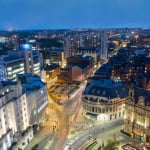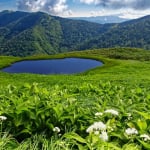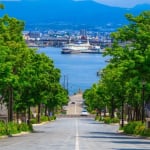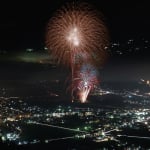Name: Shōin Shrine
Address: 1537 Tsubaki Higashi, Hagi City, Yamaguchi Prefecture
Official/Related Website: https://showin-jinja.or.jp/
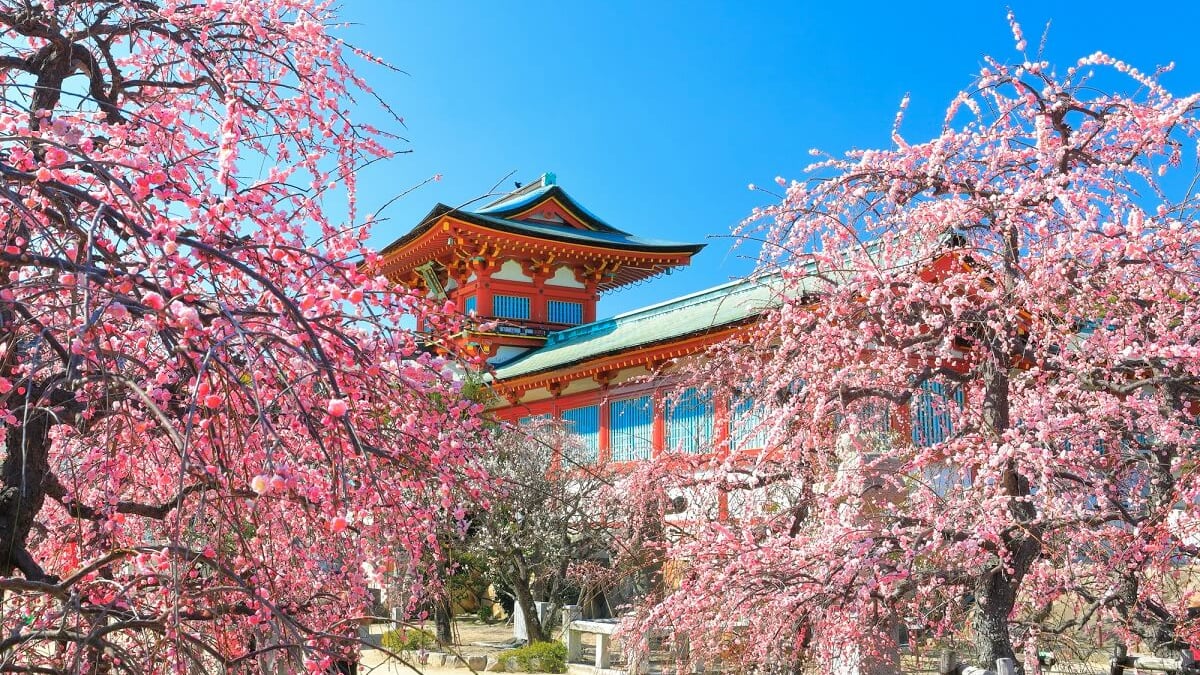
The end of the Edo period, the Meiji era, the Yayoi period… 16 spots recommended for history buffs in Yamaguchi Prefecture
Yamaguchi Prefecture played a crucial role in history as the Chōshū Domain during the Bakumatsu period. As a result, it is home to many notable historical sites, including Dan-no-Ura, the location of the final battle between the Genji and Heike clans, as well as numerous spots related to the samurai of the late Edo period and key figures of the Meiji government. This page introduces a carefully selected list of must-visit historical sites in Yamaguchi Prefecture, especially for history lovers.
table of contents
[x] close
The end of the Edo period, the Meiji era, the Yayoi period… 16 spots recommended for history buffs in Yamaguchi Prefecture
- 1. Shoin Shrine
- 2. Togyo-an
- 3. Hofu Tenmangu Shrine
- 4. Chofu Domain Samurai Residence Tenement
- 5. Chofu Mori Residence
- 6. Katsura Taro's Former House
- 7. Hirobumi Ito's Former House and Villa
- 8. Hanae Teahouse
- 9. Horiuchi Keyaki
- 10. Noyama Prison Site & Iwakura Prison Site
- 11. Doigahama Ruins and Anthropological Museum
- 12. Iwakuni Castle
- 13. Hagi Castle Town
- 14. Kozanji Temple
- 15. Dannoura Battlefield Site (Mimosusogawa Park)
- 16. Kintai Bridge
- ◎ Summary of recommended historical spots in Yamaguchi Prefecture
1. Shoin Shrine
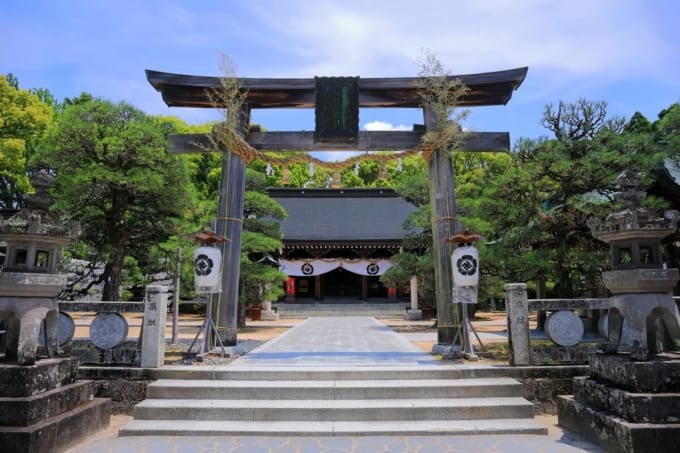
Shōin Shrine is a shrine dedicated to Yoshida Shōin. Its sacred objects include the inkstone and writings used by Shōin. In addition to the main shrine, visitors can explore Shōka Sonjuku and his former residence, both of which are designated as World Cultural Heritage sites. This historical spot allows visitors to imagine the life of Shōin and other influential figures of the time.
Yoshida Shōin was a prominent thinker from Yamaguchi during the Bakumatsu period. He was deeply affected by the arrival of the Black Ships and attempted to board Commodore Perry’s fleet, which led to his house arrest. Despite this, he founded the Shōka Sonjuku private school, where he mentored many students.
Among his students were Itō Hirobumi, Takasugi Shinsaku, Yamagata Aritomo, and Kusaka Genzui—figures essential to the history of the Bakumatsu and Meiji periods. Shōin was executed at the young age of 30, but his ideas and teachings were carried forward by many revolutionaries, fueling the movements that led to the Meiji Restoration.
2. Togyo-an

Located in Shimonoseki, Yamaguchi Prefecture, Tōgyō-an is the final resting place of Takasugi Shinsaku, a famous commander of the Kiheitai militia. His beloved concubine, Ouno, became the first caretaker of the site, tending to his grave.
Later, with the support of figures like Itō Hirobumi, a new shrine was established at the site, making it a popular destination for Bakumatsu history enthusiasts. Takasugi Shinsaku was a radical figure, often called the "stormy hero of the Bakumatsu period," whose life was cut short by the turbulent times.
He played a crucial role in defending the Chōshū Domain during critical moments, but due to his frail health, he succumbed to tuberculosis at just 27 years old. Despite his short life, his passionate and dramatic legacy continues to attract history fans today.
Name: Tōgyō-an
Address: 1184 Yoshida-machi, Shimonoseki City, Yamaguchi Prefecture
Official/Related Website: https://www.tougyouan.jp/
3. Hofu Tenmangu Shrine
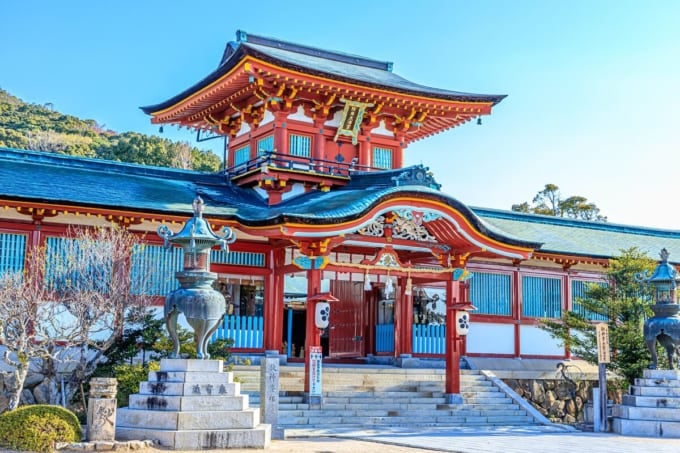
A Tenmangū Shrine is a type of shrine dedicated to Sugawara no Michizane, a revered scholar of the Heian period and the deity of learning. These shrines are found all over Japan, but the oldest among them is Hōfu Tenmangū in Yamaguchi Prefecture.
Michizane visited Hōfu and was so fond of the place that he reportedly said, "When I die, I want to return to this land." In 903 (Engi 3), while his remains were being transported by ox-drawn cart, the ox suddenly stopped in Hōfu. Believing this was a sign that Michizane wished to be buried there, the people established Hōfu Tenmangū Shrine at the site.
The shrine grounds also include a historical museum displaying important cultural artifacts, as well as a secret hideout that once sheltered Bakumatsu-era revolutionaries. It is a must-visit spot for not only those praying for academic success but also history lovers.
Name: Hōfu Tenmangū Shrine
Address: 14-1 Matsuzaki-chō, Hōfu City, Yamaguchi Prefecture
Official/Related Website: https://www.hofutenmangu.com/
4. Chofu Domain Samurai Residence Tenement
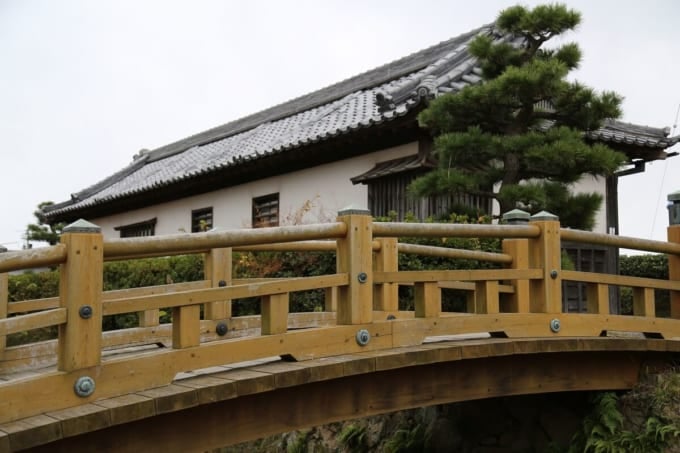
Located in Shimonoseki, Yamaguchi Prefecture, the Chōfu Domain Samurai Residence Rowhouses are a historical site where a samurai residence belonging to a branch family of the domain’s chief retainer was relocated approximately 500 meters from its original location. Today, it is designated as a cultural heritage site of Shimonoseki City.
Based on its size and architectural style, the residence is believed to date back to the late Edo period. Unlike ordinary rowhouses, it has a robust structure, and its lattice windows for the servant quarters indicate that it was a residence for high-ranking samurai.
This site offers a glimpse into the lives of upper-class samurai during the late Edo period. Located in Shimonoseki City, it is open to visitors year-round for free. If you're exploring historical sites in the area, a visit to the Chōfu Domain Samurai Residence Rowhouses is highly recommended.
Name: Chōfu Domain Samurai Residence Rowhouses
Address: 1-1 Chōfu Samurai-machi, Shimonoseki City, Yamaguchi Prefecture
Official/Related Website: https://yamaguchi-tourism.jp/spot/detail_18716.html
5. Chofu Mori Residence
The Chōfu Mōri Residence was built in 1903 (Meiji 36) by Mōri Mototoshi, the 14th head of the Chōfu Mōri family, in Shimonoseki, Yamaguchi Prefecture. Although relatively new compared to other historical sites, it is an important heritage site, as even Emperor Meiji himself once stayed here.
The stately main house, surrounded by white walls, is built in a traditional samurai residence style, making it look straight out of a historical drama. The site hosts historical lectures and offers experiences such as wearing authentic samurai armor or court lady attire. Couples can also participate in a unique experience where they dress up as historical figures like Takasugi Shinsaku and Ouno or Sakamoto Ryōma and Oryō.
The grounds feature three distinct gardens: a shoin garden, a karesansui (dry landscape) garden, and a pond-strolling garden. Visitors can also enjoy traditional matcha and sweets while admiring the gardens. If you're in need of a break during your historical exploration, Chōfu Mōri Residence is the perfect place to relax.
Name: Chōfu Mōri Residence
Address: 4-10 Sōja-machi, Chōfu, Shimonoseki City, Yamaguchi Prefecture
Official/Related Website: https://s-kanrikousha.com/mouriteitop.html
6. Katsura Taro's Former House
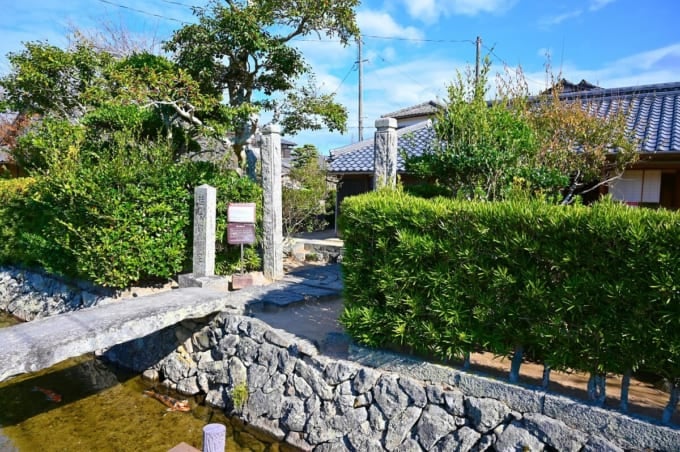
Katō Tarō was relentlessly pursued by the shogunate but narrowly escaped and went on to serve as Prime Minister of Japan three times after the Meiji Restoration. In Hagi City, Yamaguchi Prefecture, visitors can explore the historical site of Katō Tarō’s former residence. Originally from the turbulent Bakumatsu era, the house was relocated to Hagi in 1909 (Meiji 42) when the Meiji government had become firmly established.
Although the residence consists of only four small Japanese-style rooms, great care was taken in designing the garden during its relocation. Water was drawn from the nearby Aibagawa River to create a flowing pond garden. Additionally, a suikinkutsu—a traditional Japanese water feature that produces a soothing, musical sound—was installed near the veranda. Be sure to listen to its gentle tones when you visit.
Resident guides are available to provide explanations about Katō Tarō’s life and the history of the house.
Name: Former Residence of Katō Tarō
Address: 73-2 Kawashima, Hagi City, Yamaguchi Prefecture
Official/Related Website: https://www.hagishi.com/search/detail.php?d=100086
7. Hirobumi Ito's Former House and Villa
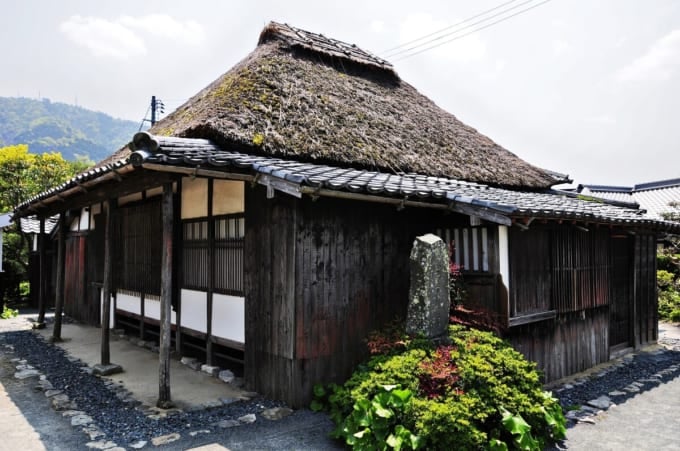
Itō Hirobumi, who studied under Yoshida Shōin and later became Japan’s first Prime Minister, grew up in this house, known as the "Former Residence & Villa of Itō Hirobumi." Like the former residence of Katō Tarō, it is also located in Hagi City, Yamaguchi Prefecture.
In addition to his childhood home, a villa that Itō Hirobumi built in Tokyo after the Meiji Restoration was also relocated here. He spent 13 years of his early life in this home, making it one of the few historical sites where visitors can experience firsthand the environment in which a great figure was raised.
Despite being a key figure in Japanese history, records indicate that Itō Hirobumi was often scolded by his mother as a child and made to stand in the garden as punishment. The stone on which he stood has since become known as the "Success Stone" (Shusse Iwa) and is a popular attraction for visitors who wish to gain some of Itō Hirobumi’s fortune.
Name: Former Residence & Villa of Itō Hirobumi
Address: 1511-1 Tsubaki Higashi, Hagi City, Yamaguchi Prefecture
Official/Related Website: https://www.hagishi.com/search/detail.php?d=100012
8. Hanae Teahouse
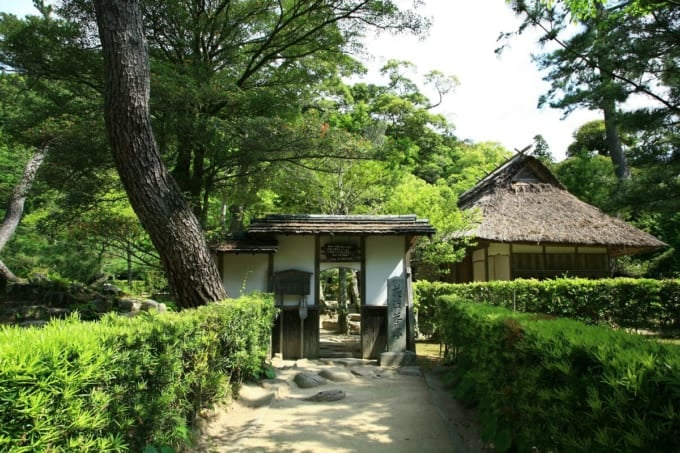
Hanae Chatei is a small tea house located within Shizuki Park, the site of Hagi Castle ruins in Hagi City, Yamaguchi Prefecture. During the Bakumatsu period, Hanae Chatei was originally part of the Sannomaru (third bailey) of Hagi Castle. It is said that Mōri Takachika, the 13th lord of the domain, discussed national affairs with his retainers here while enjoying tea. Some of the major historical incidents involving the Chōshū Domain during the Bakumatsu era may have started in this very tea room.
In 1889 (Meiji 22), the tea house was relocated from the old Sannomaru to its current location. Due to its historical significance, it has been designated as a tangible cultural property of Hagi City. However, as of November 2016, public access has been suspended for various reasons. If you plan to visit, be sure to check in advance whether it is open for viewing.
Name: Hanae Chatei
Address: 1-1 Horiuchi, Hagi City, Yamaguchi Prefecture (within Hagi Castle Ruins, Shizuki Park)
Official/Related Website: https://www.hagishi.com/search/detail.php?d=100051
9. Horiuchi Keyaki
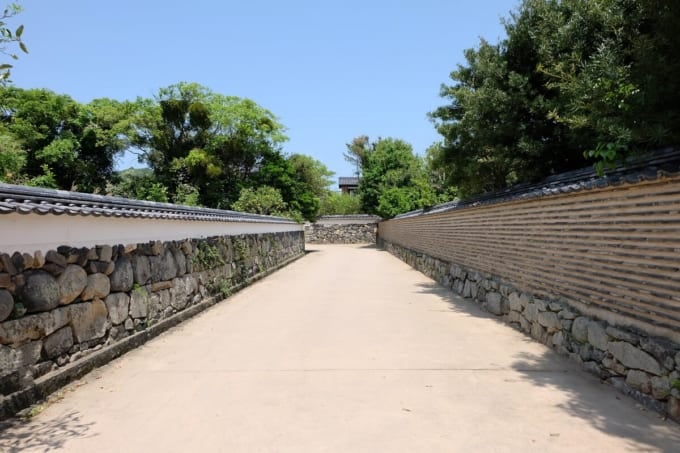
The Horiuchi district in Hagi City, Yamaguchi Prefecture, was once the Sannomaru (third bailey) of Hagi Castle. It was a critical area where the domain’s government offices were located, along with samurai residences belonging to senior retainers and higher-ranking officials.
To enhance defense, the roads were uniquely designed with sharp 90-degree bends and were flanked by tall walls on both sides. This layout was intended to disrupt invading enemies, obstruct their vision, and make it easier for defenders to counterattack or trap intruders.
If you visit Yamaguchi, take a walk through Horiuchi Key Curves and experience its historical significance firsthand. Walking between the stone walls and white-plastered fences, you may feel as if you’ve stepped back in time. Experiencing the roads on foot reveals the meticulous design and defensive strategies that went into constructing this part of the castle town.
Name: Horiuchi Key Curves
Address: Horiuchi, Hagi City, Yamaguchi Prefecture
Official/Related Website: https://www.hagishi.com/search/detail.php?d=100016
10. Noyama Prison Site & Iwakura Prison Site

The remains of Noyama Prison and Iwakura Prison are historical sites in Yamaguchi Prefecture that were once used as jails. Notable figures such as Yoshida Shōin and Takasugi Shinsaku were imprisoned here. During the late Edo period, the internal conflicts within the domain led to the imprisonment of not only pro-Meiji revolutionaries but also conservative figures.
Noyama Prison was designated for samurai, while Iwakura Prison was used for commoners. For example, Yoshida Shōin, who was arrested for attempting to board Commodore Perry’s Black Ships, was confined in Noyama Prison, whereas his attendant, Kaneko Shigenosuke, was placed in Iwakura Prison.
One remarkable story about Yoshida Shōin is that even while imprisoned in Noyama, he continued to teach his fellow inmates about Mencius and other philosophical subjects. It is said that even the prison guards were so intrigued by his lectures that they would secretly listen in.
During his time in confinement, Shōin also studied poetry and classical literature. These sites provide a profound sense of Yoshida Shōin’s indomitable spirit and serve as powerful historical landmarks.
Name: Remains of Noyama Prison & Iwakura Prison
Address: 35-6 Kongo Hagi-machi, Hagi City, Yamaguchi Prefecture
Official/Related Websites:
Noyama Prison: https://www.hagishi.com/search/detail.php?d=100003
Iwakura Prison: https://www.hagishi.com/search/detail.php?d=100004
11. Doigahama Ruins and Anthropological Museum
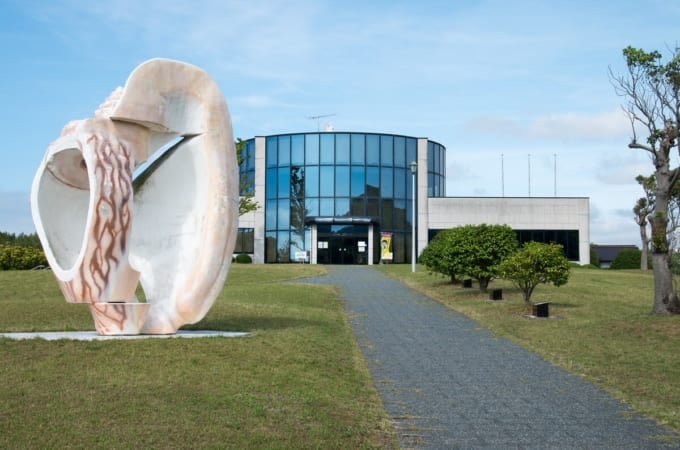
The Doigahama Ruins & Anthropology Museum in Yamaguchi Prefecture is a historical site where visitors can learn about the lives of people during the Yayoi period. The Doigahama ruins are an ancient burial site from the Yayoi era, where approximately 300 human skeletons have been excavated.
The history of the Doigahama ruins began in 1930 (Shōwa 5) when an elementary school teacher in Shimonoseki City, Yamaguchi Prefecture, accidentally discovered a stone coffin containing human remains. Initially, only six skeletons were found inside, but as full-scale investigations began, researchers uncovered a vast burial ground covering an area of 9,500 square meters.
At the nearby Anthropology Museum, visitors can view excavated human remains, Yayoi-era jewelry, and everyday artifacts. The museum also exhibits the differences in skeletal structures between Jōmon and Yayoi people.
For those looking to explore a broader range of historical sites beyond the Bakumatsu period, this is a recommended destination.
Name: Doigahama Ruins & Anthropology Museum
Address: 891-8 Kanda Kami, Toyohoku Town, Shimonoseki City, Yamaguchi Prefecture
Official/Related Website: https://www.doigahama.jp/index.html
12. Iwakuni Castle
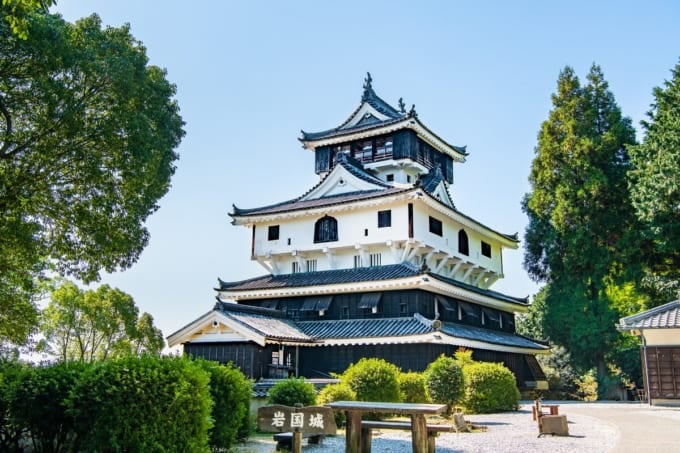
Iwakuni Castle, located in Iwakuni City, Yamaguchi Prefecture, was built in 1608 (Keichō 13) by Kikkawa Hiroie, the first lord of the Iwakuni Domain. He strategically utilized the meandering Nishiki River to create a natural fortress by constructing the castle on a mountaintop.
However, when the Tokugawa shogunate issued the Ikoku-ichijōrei (One Castle per Domain Law), the castle was demolished after only seven years. The materials from the dismantled castle were repurposed and used for domain headquarters until the Meiji era. Iwakuni was finally recognized as an official domain in 1868 (Keiō 4), but only three years later, the Meiji government issued the Haihan-chiken (Abolition of Domains and Establishment of Prefectures), leading to the immediate dissolution of the domain.
Iwakuni Castle was directly affected by two historical tragedies. In 1962 (Shōwa 37), the castle tower was reconstructed atop the mountain. Inside the castle, visitors can explore historical exhibits, including samurai armor.
A ropeway connects the base of the mountain at Kikkō Park to the castle’s summit, where an onboard announcement provides historical insights. From the castle keep, visitors can enjoy panoramic views of Iwakuni City, as well as the Seto Inland Sea and even the distant islands of Shikoku.
Name: Iwakuni Castle
Address: 3 Yokoyama, Iwakuni City, Yamaguchi Prefecture
Official/Related Website: https://kankou.iwakuni-city.net/iwakunijyo.html
13. Hagi Castle Town
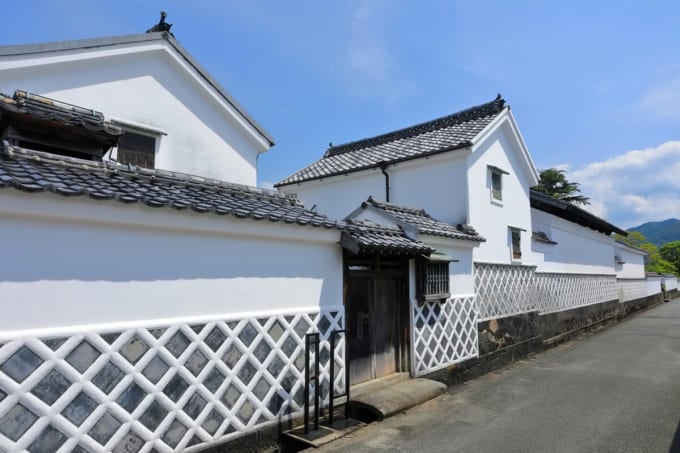
Hagi City in Yamaguchi Prefecture was where Mōri Terumoto built Hagi Castle in 1604. The castle town flourished for 260 years, and some parts of the town still preserve its historical atmosphere today.
One of the most recommended areas to visit is Kikuyayokochō, where the residence and mud walls of the Kikuya family, once a wealthy merchant house, remain well-preserved. This allows visitors to experience an Edo-period townscape as it originally was.
Additionally, near Kikuyayokochō are the birthplaces of Takasugi Shinsaku and the former residence of Kido Takayoshi, making this a perfect site not only for those interested in the Edo period in general but also for fans of Bakumatsu history. Walking through the area at a leisurely pace while imagining the lives of historical figures can be an enriching experience.
Due to its historical significance, Hagi Castle Town has been designated a UNESCO World Heritage Site. The Horiuchi district, in particular, has been recognized as a National Important Preservation District for Groups of Traditional Buildings.
Name: Hagi Castle Town
Address: Minami Kogahagi-machi, Hagi City, Yamaguchi Prefecture
Official/Related Website: https://www.hagishi.com/recommended-routes/jyokamachi/
14. Kozanji Temple
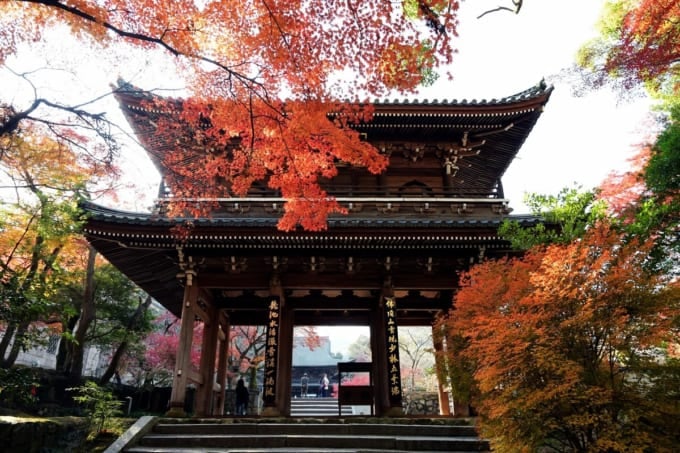
Kozanji Temple in Shimonoseki City, Yamaguchi Prefecture, is a historically significant temple built in the Kara-yō (Chinese-style) architectural design of the Kamakura period. It is also known as the family temple of the Chōfu Mōri clan. As a temple that was once a Chokugan-ji (imperial prayer temple) of Emperor Go-Daigo and received patronage from the Ashikaga clan, Kozanji holds a prestigious position among Yamaguchi's temples.
Additionally, Kozanji is beloved by history enthusiasts because it was the site where Takasugi Shinsaku launched his Kiheitai Rebellion. It is said that if this rebellion had not occurred, the Meiji Restoration would have been delayed by several years. The turbulent history that shook Japan began at this very location.
Within the temple grounds stands an equestrian statue of Takasugi Shinsaku. For those interested in Bakumatsu history, visiting Kōzan-ji is a must. The temple is also famous for its cherry blossoms and autumn foliage, with several centuries-old trees adding to the historic atmosphere.
The trees within the temple grounds have quietly witnessed the turning points of history. Standing in such a place may evoke profound feelings of connection to the past.
Name: Kozanji Temple
Address: 1-2-3 Chōfu Kawabata, Shimonoseki City, Yamaguchi Prefecture
Official/Related Website: http://kouzanji.org/
15. Dannoura Battlefield Site (Mimosusogawa Park)
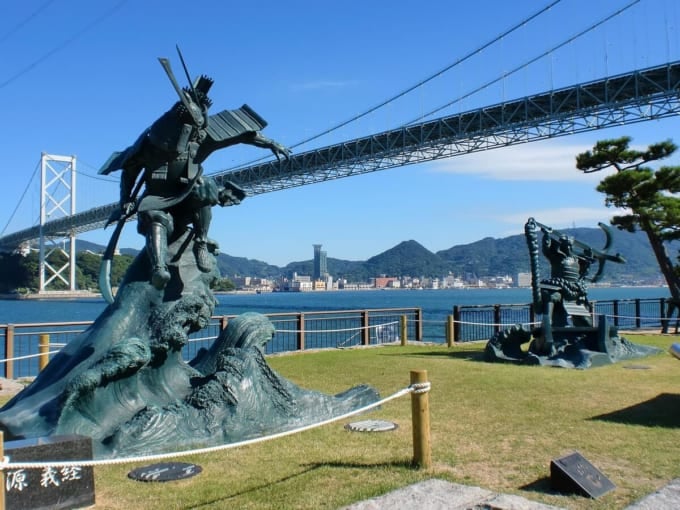
Mimosusogawa Park, located along the Kanmon Strait in Shimonoseki City, Yamaguchi Prefecture, is the site of the famous Battle of Dan-no-ura in 1185. In this battle, the once-powerful Taira clan was defeated by the Minamoto clan, marking the rise of the Kamakura shogunate. Cornered by the Minamoto forces, Emperor Antoku drowned himself here alongside his guardian, Nii-no-Ama, bringing an end to the Taira's dominance. However, the victorious Minamoto no Yoshitsune was later pursued by his brother Yoritomo and ultimately met his tragic end in flames at Hiraizumi in Iwate.
Mimosusogawa Park was also a key location in the Bakumatsu period, where the Chōshū Domain fired cannons at foreign ships. This act led to an international conflict, resulting in the occupation of Shimonoseki by the allied fleet. This event played a role in convincing the Chōshū Domain to support the opening of Japan to foreign trade.
Thus, two major turning points in Japanese history originated from the same location in Yamaguchi Prefecture. The park features statues of Minamoto no Yoshitsune and Taira no Tomomori, along with historical markers such as the Dan-no-ura Battlefield Stone Monument and a replica of a Bakumatsu-era cannon.
Name: Mimosusogawa Park
Address: 1 Mimosusogawa-chō, Shimonoseki City, Yamaguchi Prefecture
Official/Related Website: https://yamaguchi-tourism.jp/spot/detail_15266.html
16. Kintai Bridge
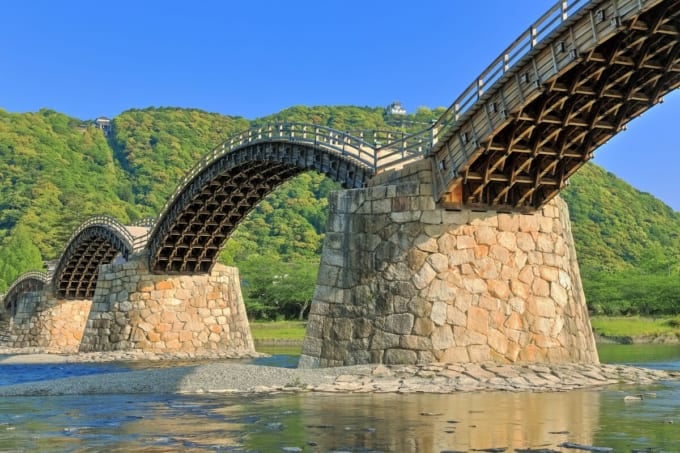
Kintai Bridge is one of Yamaguchi Prefecture's most famous landmarks. Many may recognize its distinctive five-arched wooden structure from television or magazines.
The history of Kintai Bridge dates back to 1600 (Keichō 5), when Iwakuni Domain’s lord, Kikkawa Hiroie, built a castle and castle town. The Nishiki River, which divided the two, was notorious for being an uncontrollable, raging river. The third lord, Kikkawa Hiroyoshi, finally succeeded in constructing a bridge after numerous failed attempts and design revisions, completing it in 1673 (Enpō 1).
Unfortunately, the bridge was washed away in 1953 by Typhoon Kijiya. However, the current fourth-generation bridge was rebuilt using traditional wooden joinery techniques, preserving its historical craftsmanship.
Kintai Bridge stands as a testament to the determination of Yamaguchi’s people and their extraordinary engineering skills.
Name: Kintai Bridge
Address: Iwakuni, Yamaguchi Prefecture
Official/Related Website: https://kintaikyo.iwakuni-city.net/
◎ Summary of recommended historical spots in Yamaguchi Prefecture
Yamaguchi Prefecture is home to numerous historical sites spanning various eras, with a particular focus on locations related to the Bakumatsu-period revolutionaries of the Meiji Restoration. The prefecture has played a pivotal role in key turning points in Japanese history, making it a historically significant region. Even those who may not have a deep interest in history will likely recognize some of the names and places associated with Yamaguchi.
If you have the opportunity to visit Yamaguchi Prefecture, be sure to explore its historical sites. Walking through the places where legendary figures once lived and made history offers a unique experience beyond ordinary sightseeing. Instead of just learning from textbooks or period dramas, you can step directly into the settings where history was shaped.
RELATED ARTICLES
REGIONS
CATEGORIES
FEATURED ON Yamaguchi
-
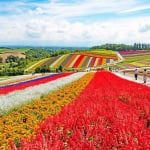
Where will you go for the summer vacation? Introducing recommended spots for domestic travel
-
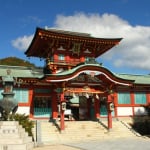
4 Fun and Recommended Tourist Spots in Hofu City, Yamaguchi Prefecture!
-
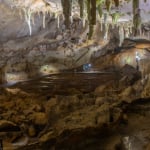
[Yamaguchi Prefecture] Introducing Tourist Information for Akiyoshido! Enjoy an Extraordinary Cave Exploration!?
-
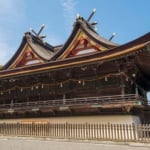
[4-day holiday in the Chugoku region] Summary of summer outing spots ◎ Enjoy the great outdoors!
-

The 5 best recommended tourist spots in Yanai City, Yamaguchi Prefecture, famous for its white-walled streets and goldfish lanterns
MOST POPULAR ON Yamaguchi
-
 1
1Doha: Must-see Attractions in the Capital of Qatar
-
 2
2Toronto: 10 Things to do in this Picturesque Canadian City
-
 3
3Amarillo: A City Famous for It’s Amazing Canyons, Great History and Music
-
 4
4South Korea: Dazzling Scenery, Rich Culture and Fascinating History
-
 5
5Kuwait: A Country in Middle East Asia Famous for Hot Sand Dunes and Stunning Cityscape

